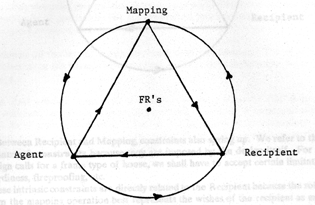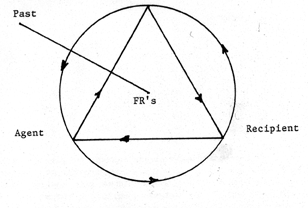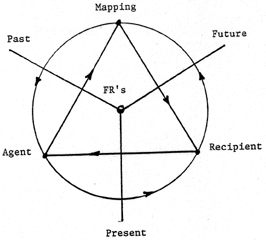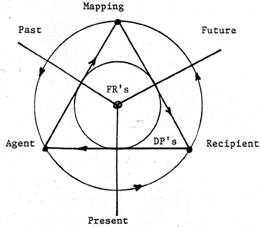
GUIDED PROJECT Introduction to the Process of Design:
Many definitions have been proposed for design - In essence, designing is providing a set of prescriptive rules for reorganizing the elements of the environment according to some purpose. The environment can be physical, economic, social, political, bios pherical, mental, spiritual etc... The environment is as vast and diversified as human reach and beyond! Engineering design generally has strong physical, economic and biospherical components but has elements pertaining to these other dimensions also. Design is an activity that begins with an idea and results in a product, though the product itself is not the end. While designing the product, thought must be given to the distribution, use, maintenance, operation, eventual recycling and the probable e ffect of the product on the environment.
Design is not just "making things"; design is fundamentally a "way of doing things", which is applicable to all purposeful, "thought-out" activities. It is characterized by decision making. A philosophy of design is therefore, eventually, a philosophy o f human action.
No matter the field of application, design is a process of interaction between a number of factors. First there has to be a need, a desire by someone somewhere (the client or recipient) for something that the design process can bring forth. If no one wa nted homes, architects and builders would soon be out of work. Second, there has to be an agent who can meet these needs, understand them and satisfy them. If there are no builders and architects around, no amount of wishing will make the houses appear. When both agent and client come together, through dialogue (communication), they establish the specifications for the design (Functional Requirements FR's)

Of course, both agents and recipients have their own viewpoints to start with. Their viewpoints are determined by their backgrounds, training, interest in the project, etc. Viewpoints may change as levels of awareness and understanding change, as those involved see the project in relation to themselves, their families, companies or communities, etc. The interchange between agent and recipient will establish the common ground which will result in an agreed-upon set of specifications or Fundamental Requ irements for the design. Having agreed on the specifications, the agent will go to work figuring out various ways in which (s)he can satisfy them and trying to select the best one. This is the level at which decisions regarding the matching or mapping o f the concepts onto the physical reality takes place. It requires a great deal of interaction and communication, and of iteration.

Note an important point here, namely that the interchanges between the three design factors (agent, recipient and mapping) are constrained by a number of elements:
2. between agent and mapping we have another set of constraints. The agent is not free to choose any solution (s)he pleases but is limited by a set of external (or extrinsic) constraints such as natural laws (physical, biological etc.) or laws and regula
tions imposed by some external authority (e.g. if you want to build a house there are zoning laws, environmental regulations, building codes which have to be followed as well as fundamental principles of statics). Most of these constraints are, to a gre
at extent, the result of what has gone on in the past. They are not easily changed. To remind us of their origin we draw a line labeled "Past" out from the center (FR's) to the left side of the triangle. The left side of the triangle itself will symbol
ize all these extrinsic constraints.
3. Between Recipient and Mapping, constraints also spring up. We refer to them as internal or intrinsic constraints because they are imposed by the design itself. For instance, if the design calls for a frame type of house, we shall have to a
ccept certain limitations on height, sturdiness, fireproofing, etc. These intrinsic constraints are directly related to the Recipient because the solution resulting from the mapping operation best represents the wishes of the recipient as embodied in t
he agreed-upon specifications. It can also be seen that these constraints, symbolized by the R.H. side of the triangle, govern the future of the design. That is why we draw a line so labeled out from the center to the triangle R.H. side.
The human constraint between Agent and Recipient is always subject to change from moment to moment (within limits, of course) since it ultimately depends on the states of consciousness of both parties. It is therefore reasonable to see it as connected w
ith the present. The space within the triangle symbolizes therefore the design space, the space within which any possible solution satisfying the specifications or functional requirements (FR's) will lie.
It is within this triangle of constraints that the standpoint of the agent is established. The standpoint governs the reach of the agent's authority or the sphere of action. The standpoint characterizes what the agent can do. The viewpoint governs what the agent can see and understand. It is obvious that we often may envisage a multitude of possibilities but are constrained by circumstances to precious few, as the five feet between our eyes and our soles remind us.
Obviously all the sets of constraints react upon one another. This is shown through the double counter circulations in the triangle of constraints and the outer circle respectively establishing three main feedback loops.
The ideal solution, embodied in a set of design parameters (DP's) specifying actual physical dimensions, numbers, material choices etc. in the case of an artifact, or statements and procedures in the case of a software for instance, is symbolized by the i
nner circle tangent to the constraints. Tangency indicates that the constraints are met but not exceeded, the circular form symbolizes the optimality of the solution. The external circle represents the process as a whole.
This simple diagram can represent any design process, any thought-out action. It represents in fact the structure of a sentence when the agent stands for the nominative; the recipient, the dative; the mapping, the instrumental; the FR's, the ablative; th
e DP's the accusative; the constraints, the locative; the action as a whole, the verb governed by the appropriate tense: past, present or future.
If this apparent coincidence surprises you, reflect on the nature of language and of design. Language being the articulation of thought, is at the core of the design process. The fundamental rules of language must therefore be the fundamental rules of d
esign. The creative process is essentially the same in all human activities. That the product of the design be a sound time-series as in a poem, or a report, a two-dimensional display of graphical clusters as in a visual display, a three-dimensional obj
ect or any kind of system or process is not essentially relevant. In all cases, it is a re-ordering of the elements of the environment according to some purpose as previously noted; and though the superficial properties of the object involved, and of the
ir relationships, may differ according to their respective natures, in each case, the "deep structure" of the design act remains the same.
In this course you will have to complete a project, to design a report, an oral presentation, a set of visual displays and do and execute many other actions. It may help you to understand that the underlying structure of all this is essentially the same.
If you are perceptive and attentive you will learn a great deal by remembering this structure. If not, you will happily and heedlessly follow the fate of the American bison galloping with the herd over the cliff. The point is that you are given four
chances to experience the design process in four different circumstances while completing your project. Appreciate what is specific in each case and what is common to all.
Report writing, oral presentation, and visual display, like Engineering Design, require synthesis - bringing together disparate elements. So that you (the agent) wear your engineerıs hat, your writerıs hat, your partnerıs hat or your visual artistıs hat,
you have in all these cases to figure out:.
- enables the students to work on practice-oriented projects;
A pedagogical team consisting of:


- what is needed in terms of artifacts, words, or visuals (design parameters);
In all these activities you proceed and iterate through similar phases which may be simplified to:
for whom (recipient, client, audience);
- why (functional requirements);
- in what form or language (extrinsic constraints);
- in what shape (intrinsic constraints, document design).
gathering information
A more elaborate listing would include for engineering (with suitable modification for the other areas) the following phases:
planning
drafting/sketching
testing, evaluating, getting feedback
revising and editing
Phase
Process
1 The Problem
- Defining the Problem
- Setting objectives
- Determining Constraints
- Nature, Kind and Sources of
- Information Needed
- Information Gathering
2
Options and Solutions
- Establishing Design Criteria
- Generating Options and Solutions
3 Options Evaluation
- Evaluation of Options
- Ranking of Options
- Selection of Preferred Option(s)
- Knowledge Base for Preferred Option(s)
4
System Analysis
- Feasibility Study of Preferred Option(s)
- Detailed Analysis of Preferred Option(s)
- provides a heuristic problem-solving methodology and a systematic approach which is generic to all engineering problem-solving;
- emphasizes team work - allows the student to work as an individual in a team and at the same time to assume a leadership role;
- offers forums for the students to communicate both orally and in writing to their supervisor, instructor, colleagues, co-workers, and occasionally to their clients;
- naturally presents the need for a broader and thorough knowledge base, scientific or otherwise, which has to be acquired to complete the project successfully;
- teaches the students the skill of literature search and information gathering procedure;
- imbues in the student the need to include technical, environmental, socio-humanistic, political, and economic factors into the decision-making process, and particularly to consider the implications of the non-technical factors in a presumably ³technical
² problem;
- allows the student to work collaboratively and cooperatively in a team and to interact with other people outside of the team; and
- imbues the student with a sense of time - it requires that the students budget their time and work under the pressure of deadlines.
your engineering instructor
The dates at which these consultants will be available are attached.
a consultant for written presentation from the Writing Center
a consultant for visual display
a consultant for library utilization
will assist you with various aspects of your project, working with groups in a studio setting.
Course Structure Groups Design Project Schedule Research U Online Tutorials Frontispiece